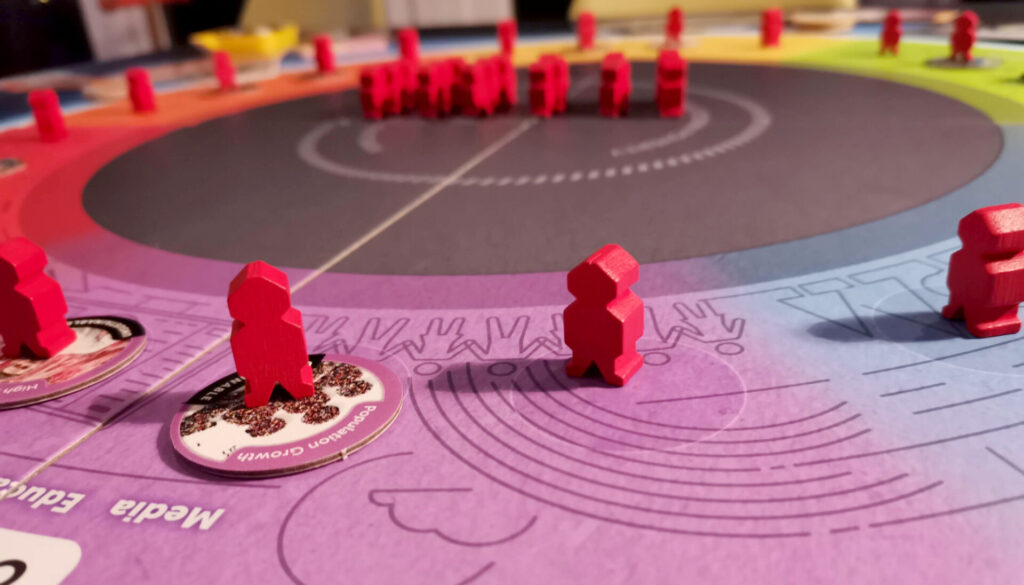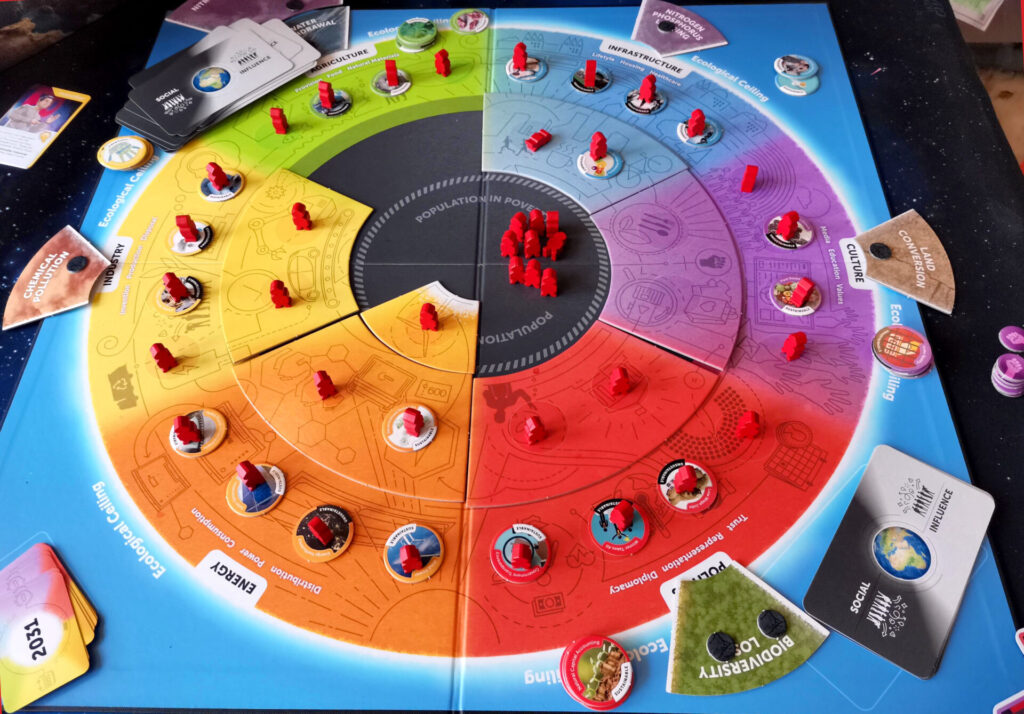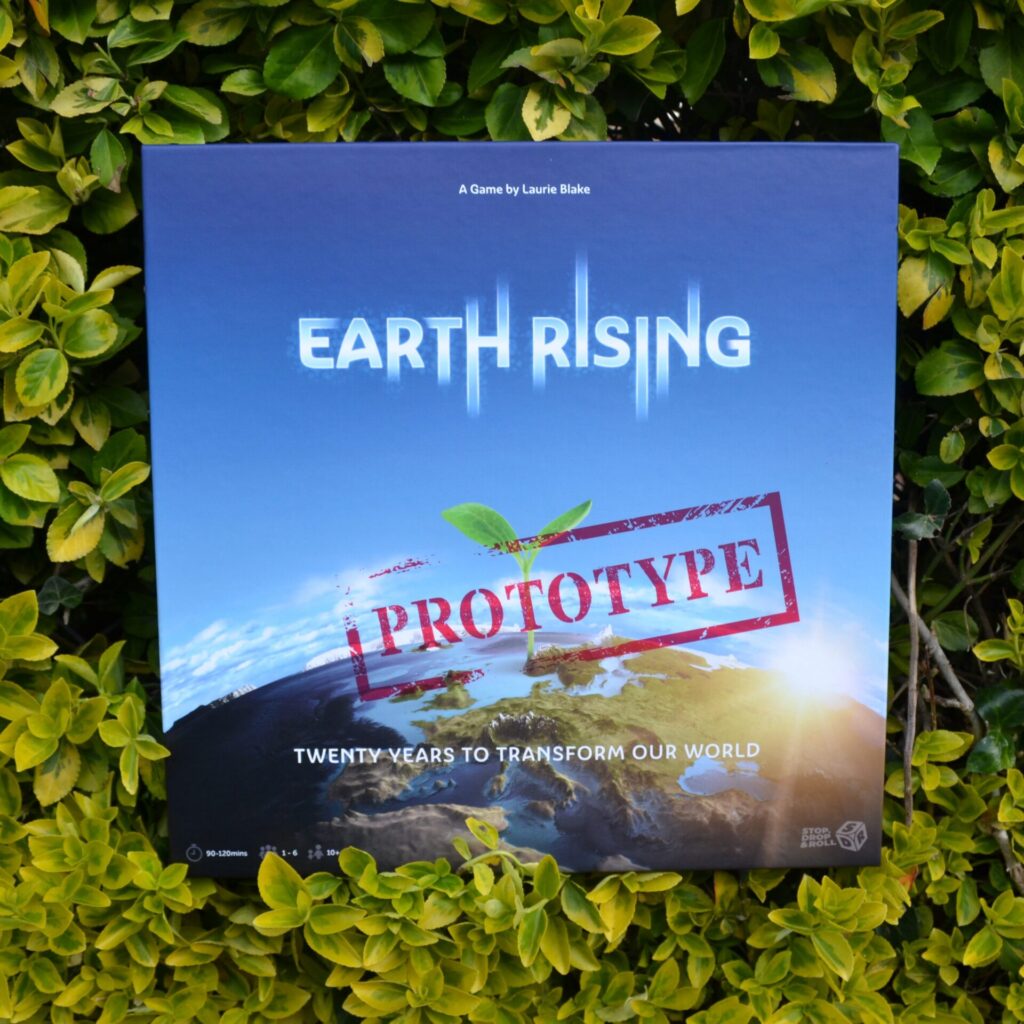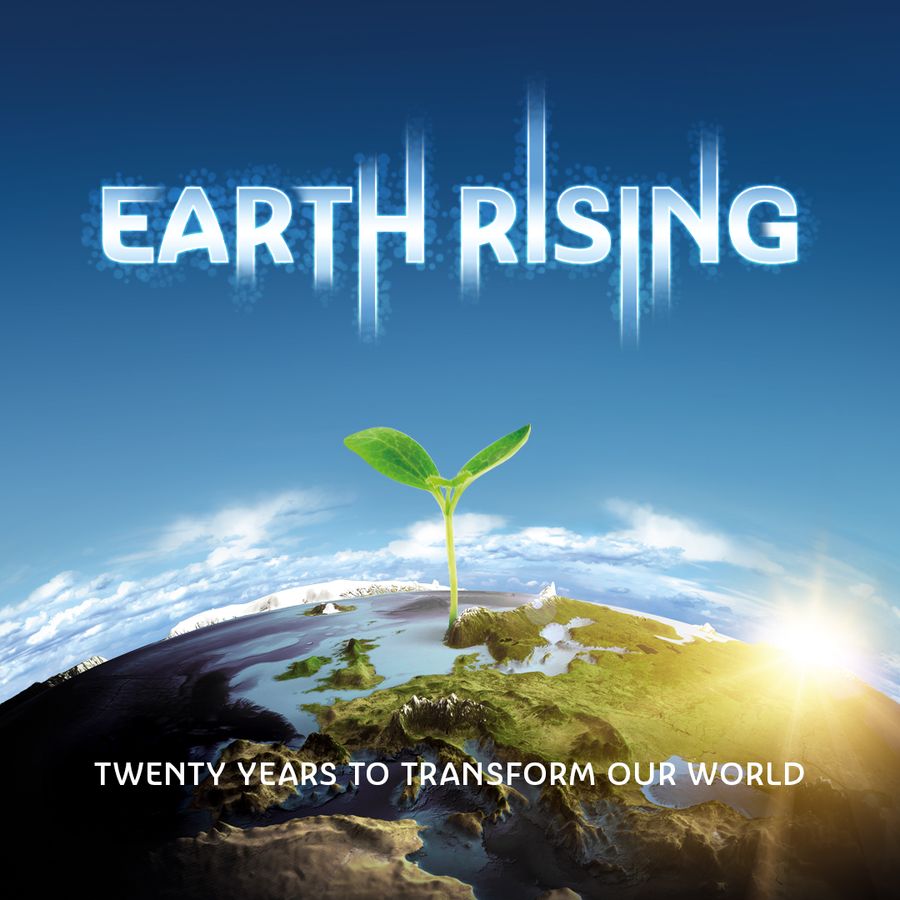Disclaimer: This preview is based on a pre-production prototype of the game, which may change before a full release. Game components pictured are not indicative of the final quality
Earth Rising is a co-operative game which gives the players a straight-forward yet monumental task – save the planet in twenty years. No pressure then! Backed up with a frankly ridiculous amount of real-world science and study, players take on the roles of influential people in this fight, including Ecologists, Innovators and Activists, working together to try to find a way to sustain the world’s population, and make it a tenable place to live for future generations.
Role playing
The huge board represents the world, and the various sections represent sectors, such as Industry, Agriculture and Politics. In the centre, rows of meeples represent the world’s population living in poverty, while others in the coloured areas are clusters of population supported by various practices. They may not be good practices, but they support people all the same. On their turns players are drawing cards, carrying out actions like disbanding practices and introducing new ones (little cardboard discs), or reducing the number of strain tokens strewn around the planet.
Players also get special abilities, based on their chosen role. For example, the Ecologist can add green regeneration tokens to the board, which reduce the amount of strain added at the end of each turn. If players work together to best use these special abilities, the challenge becomes much easier – which I guess is an allegory for the real world. When enough strain is removed from a sector, you get to do the really satisfying thing of placing a big, new, coloured board wedge onto the main board, giving you more opportunity to support more meeples (and to look at less inky-black failure).

Getting things right is great, but there are a couple of things in there to stack the odds back against you. When you draw one of the cards, which are used for developing sustainable practices, there’s a chance of drawing a Status Quo Strikes card. Far from an attack by Francis Rossi, in another act of mirroring the challenges from the real world, these cards represent people trying to cling to the old ways, and they can really mess up your game in a hurry. Get things wrong too often and you face recessions and even ecological collapse. You don’t need to be an economist or scientist to realise these are bad things that you don’t want to happen.
Hard truths
The most important thing to understand about Earth Rising, is that although it’s a game, and you’re sitting down to have fun playing it, the themes and challenges you’ll face are real. The game is centred around the world – our world – and the ecosystems that support it. Players are trying to disband harmful existing practices, and replace them with sustainable alternatives, all the while cleaning up the mess the human race has made so far.
All of the scenarios, situations, practices and challenges faced in the game are based on their real-world counterparts. Every time I played the game it made me think about the problems and situations we’re facing as real things, and far more than I usually would. Given that that’s a part of this game’s mission, I’d say it does it very well.
SDR Games have had to tread a really fine tightrope in developing Earth Rising. It’s a game that wants to deliver a powerful message, while not forgetting that it’s a game. The idea of a game, after all, is to have fun. No-one wants to be invited around to games night and find they’re being lectured to, or told that the outlook is so bleak that they go home more stressed than when they left work earlier that day. The studio have managed to walk that balance pretty well in my opinion.

The characters are somewhere between illustrations and caricatures, but not to the point of being silly, or offensive. They’re refreshingly diverse characters too. Are they stereotypes? Maybe, but I think it’s more about creating a sense of character than anything else. The board and tokens are bright and colourful, and you’re placing meeples, which immediately feels familiar for games players. They’re referred to as ‘meeple’ all the way through the game too, which I think is a conscious design choice to try to keep that slight disconnect between game and real-life. Placing a meeple into the poverty section feels less soul-destroying than condemning another 150 million people to the same fate.
Are we having fun yet?
The reason you’re all reading this is because you want to know if the game is fun. It is a game, after all. Isn’t it? Thankfully yes, it is a game, and it’s a good one at that. I’ve played some games in years gone by which were meant to raise awareness over things like environmental issues, and by and large they’ve been pretty awful. Most use roll-and-move mechanics while trying to teach you the designer’s idea of right and wrong, and aren’t too far removed from the Georgian and Victorian era games which attempted to do the same with morality, like The Mansion of Happiness. Earth Rising doesn’t do this. It doesn’t batter you over the head with “you’re bad people and need to do better!“.
Everything in the game is thoroughly researched. More than any other game I’ve played I expect. The board and the base concepts of the gameplay revolve around the Doughnut Model created by economist Kate Raworth, and it works. As a game it works, and as a concept it works. You’re forced to make hard decisions in the game all the time. Removing strain tokens with your actions means you might not be removing an unsustainable practice, and removing an unsustainable practice sounds like a good thing, surely? Long-term, yes, but until you replace that practice with something sustainable, that portion of the population is no longer supported and gets placed in poverty, adding to your strain. Argh!

It’s clear that Earth Rising is a game, and it’s been made by game designers. Designers with a passion, yes, but game designers first and foremost. It feels not-too-dissimilar to something like Pandemic in that regard – players working together to complete a single, intangible goal. The mechanisms and game balance feel like they’ve had a lot of work go into them, and unless I’ve just not come across it yet, there doesn’t seem to be a single game-breaking strategy.
I noticed straight away that the game plays solo, and because I cover a lot of solo games here, I gave it a few plays on my own. It worked better than I expected, feeling like a proper puzzle to solve. I’d have to play it more to see if some characters are more powerful as they seem to be; the Activist and Ecologist especially I found it much easier to play as than the others. This is a game made for team play though, and I think that 4-6 is probably the sweet spot.
Final Thoughts
When the good people at SDR Games first approached me to look at Earth Rising, my initial reaction was to not want to. That’s me being honest. While I’m not blinkered to the plight of the human race and our planet, I’m very much someone who looks for escapism in his games. But how can I be a good parent if I ignore the world’s issues? How can I be a good reviewer of games, if I don’t review all kinds of games, and break myself out of that self-imposed comfort zone? I’m glad I did just that, because having Earth Rising for the last couple of months has been an eye-opener for me.
Firstly, it’s made me realise that a game that deals with hard, bleak, real-world issues can still be a good game in its own right. Earth Rising is a good game, it’s as simple as that. If you re-themed this to some alien world and changed the practises and people to be alien technologies and things, everyone would take it on its merits as a game, it would get good reviews. That’s where the tough sell comes for games like this I think – for small studios who’ve got a message to send, and to prove that they can make good games at the same time.

It’s not the most difficult game in the world for anyone like me, who’s spent a lot of time with heavy economic or co-op games. But it’s not a game necessarily aimed at people like me. It’s a medium-weight game, and I had fun playing Earth Rising. Honest-to-goodness fun, because it’s a good game. On top of that, I would find it very hard to name another game I’ve played that implements theme so well at its core. As I mentioned above, I think it works best with more than three players, because I think it’s at its best when players are talking to one another and trying to come up with solutions to the problems.
I could see Earth Rising doing really well in a school setting. Put a few copies of this in a room full of teenagers in a secondary school and I think it’d be the perfect example of that thing that videogames tried desperately to do in the 90s: ‘Edutainment‘. If you’ve got a group that regularly has more than four people around a table and loves co-op games, I’d recommend getting it too.
The Kickstarter launches on 26th April 2021, and I think it’s worth mentioning that as well as being a labour of love, post-fulfilment profits generated by the sale of the game will go towards charities and organisations tackling the different aspects of climate change and sustainability that are explored in the game.
Preview prototype kindly provided by Stop, Drop and Roll Games. Thoughts and opinions are my own. No payment was made for the creation of this preview.

Earth Rising: 20 Years to Transform Our World (2021)
Designer: Laurie Blake
Publisher: Stop, Drop and Roll Games
Art: Rob Ingle
Players: 1-6
Playing time: 90 minutes
